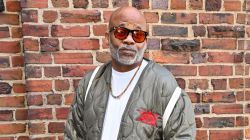In 2008, in the mainstream, you tend to hear more about a two-step with
a drink in the hand than breakin’, and crossing out names with paint
than bombing trains. Still, in most commercials pandering to an urban
audience, there’s forever room for B-boys and B-girls, and chances are,
graffiti is in the background of any such print campaign.
Helping Hip Hop reclaim its forgotten elements, Brooklyn’s PowerHouse Books has two new books that remind us of our roots. Charles Peterson‘s CYPHER finds
the famed Rock photographer globe-trotting, and at times, letting the
globe come to him, to let his camera lens and some sophisticated prose
unearth the bond that lies in the B-boy circle, and just how much this
thriving culture ought to remind Hip Hop how to carry itself.

HipHopDX: As Hip Hop music, or rap paid less attention to the
breakin’ element of the culture, from your photographs and
observations, do you think the breakdance community has woven itself
tighter, identifying separately from “Hip Hop” as it was once defined?
Charles Peterson:
I think in some ways it actually has. Of course they are all fans of
Hip Hop music, but they also do their thing to Soul, breaks, House, you
name it – DV One even spins German Prog Rock group Can.
I also think they are less about throwing poses and attitude. That only
gets you so far – one has to step up and step into the cypher. And it
takes a lot of skill and conquering of fear to do that which also sets
them apart. To me they are almost more like the skateboard subculture
which defines itself as both part of but also separate from the
punk/rock scene, and actually brings in lots of separate influences and
personalities.
DX: From the title CYPHER onto the photographs, your
collection truly shows the fraternity of breakers. Talk to us about
that, and to what extent is it the same across the globe, or different.
Charles Peterson: Well, my initial idea for CYPHER
was to do a global take of the B-boy world, but that was a little
unrealistic for financial reasons. But what I soon realized is that
B-boys and B-girls travel the world themselves so I really didn’t need
to leave home, so to speak! For example, Korea was really on my radar,
and I managed to capture some of the best crews at a large event in
L.A. [called] Freestyle Sessions. So the world of breaking is
borderless and at this point I’m pretty sure one could find
practitioners in just about every country in the world. In the book I
have a photo of schoolkids throwing freezes in downtown Saigon. I just
happened upon them – I saw them forming a circle and was like – ah ha!
So even the unspoken language is the same. The cypher, the footwork,
the freezes – these all translate without the need for a common
linguistic language – it’s all about body language. And it can be
practised by anyone anywhere which is the ultimate definition of
globalization.

DX: By nature, dance is fast paced, driven off of motion. What
secrets of its universe do you think are unveiled in a cleverly timed
photograph within it? What have you learned from these moments in time?
Charles Peterson: Oh
man, good question! I think a certain grace and classicism is unveiled
that links breaking to the lineage of serious dance, such as modern,
ballet, etc. Breaking can be so fast and have a certain wow effect to
it, but often the subtleties and beauty of the movement is lost in the
speed of the motions. Dance is universal, and ancient. It’s that
connection with timelessness, despite the fashions – which I enjoy,
that I hoped to bring across with my photographs.
DX: As major media continues to exploit break culture, to what
extent do you think the community has reacted? In the wake of
McDonald’s showing young, Black kids breaking over winning at
Monolopoly, has the “cypher” tightened?
Charles Peterson: That happens to every pop culture of course. I’m [in] Paris, where I had an opening of my Nirvana photos, where a movement called parcours was really underground among the North African kids but is now everywhere (read James Bond). There’s a new dance movement called Tecktronic
that I’m sure will cross borders and oceans soon enough. My point is
that everything gets co-opted sooner or later. Everybody needs to make
money. It’s a bummer but can also mean validation on another level. If McDonald’s
gives some kid a few [thousand dollars] to dance in a commercial, that
means that kid or his crew can travel to a lot of jams. Eventually, the
corporate interest fades ands moves onto something else but the true
believers keep soldiering on because it’s fun and it’s what they know
and believe in and nobody can take that away from them.
DX: Along those lines, in a culture that’s perceived as so
intentional, so stylized, how much would you say — and would your
work say, that the element of cool, hip, swagger – call it whatever is
completely natural to these subjects? At the epicenter of cool, is
anything really forced?
Charles Peterson: I actually think very little is forced. Of course, the younger you are, the more everything is forced! That’s part of being young – what you
believe in is the most important thing in the world. But with B-boys
and B-girls the energy they project is so strong and addictive. Very
different from the young hoodlums I have living across the street from
me – gold chains, black Lexus, sideways caps, Hennessy
bottles that end up on our lawn. Incredibly forced – and annoying. Not
cool at all. But most of the B-boys and girls I’ve met have a respect
for themselves and others sorely missing in a lot of the “rap” scene. A
lot of that comes from the immense core strength needed to break – that
strength serves them well in their lives as well. It’s almost like
practicing a martial art. And that’s the energy and attitude that
inspired me to make these photos.

Next up, PowerHouse has also recently released Vandal Squad. This effort finds New York Police Department retiree Joseph Rivera writing about his 20 years in the Vandal Squad, the institution responsible for cracking down on graffiti writers throughout the city.
What makes Rivera so intriguing, amidst a book that covers
the tactics, glossary, wanted lists and underground lairs of the squad,
is that it’s hard to tell where he stands. Even though he arrested
hundreds of writers and helped transition New York from the ’80s to
present day, HipHopDX‘s brief conversation with the author suggests that he respects his adversaries and understood the streets as well as they did.
HipHopDX: What was the evolution like from when you started in 1984 to the
book’s end in 2004? How had New York changed, and how had its “graffiti
vandal” adapted to that?
Joseph Rivera: Back
in 1984, riding the subway was always an adventure. You never knew what
was going to happen. The trains were covered with graffiti inside and
out. There was no air conditioning, just fans blowing hot air. They
were also extremely dirty. Working in the subway during that turbulent
time allowed me to really appreciate the graffiti-free environment I
helped create for the citizens of New York City. I was able to observe
first hand, the graffiti movement change it









